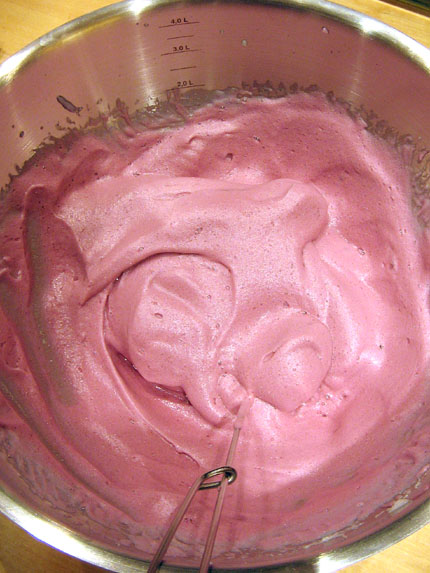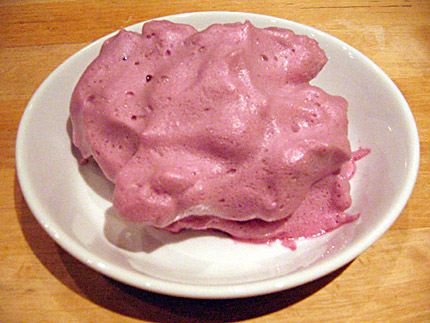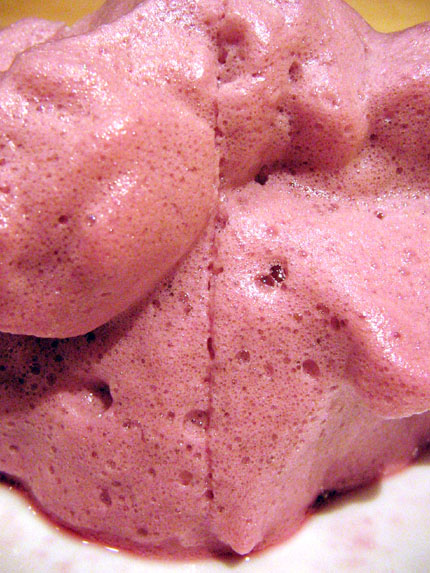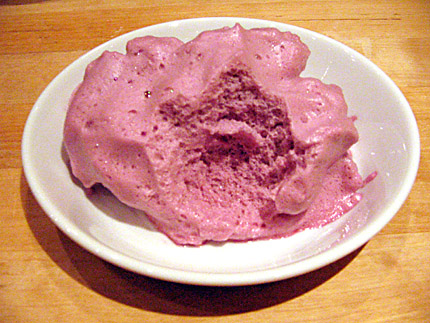By beating air into an egg white you can increase it’s volume by a factor of approximately 8. Hervé This has shown that water is the limiting component. By adding more water you can significantly increase the volume. Addition of sugar further stabilises the foam by increasing the viscosity of the water. A very simple dessert kan be made by whisking egg whites with sugar and berries of your choice. In Norway we refer to this as “Troll cream”. There’s more on this over at eriks-food-ucation.blogspot.com. An interesting question for you to ponder upon is in what order egg whites, berries and sugar should be mixed to maximize the volume!
But there is more to such a foam than trolls! For the following experiment, use one eggwhite and a berry syrup of your choice – I used a blueberry syrup (approximately 1,5 dL). Start by whisking the egg white. Add the syrup slowly over 5-10 min while constantly whisking. Observe how the volume increases dramatically. When I did the experiment I got roughly 2 L of foam (which corresponds to a 40-50 fold increase in volume). Make sure you use a clean bowl, preferably one of metal as fats and oil cling very well to plastic bowls.

Now comes the fun part: Put some of the egg white foam onto a plate and place it in a microwave oven to make the proteins set! Hervé This described this in a recent article and decided to name this dish “Vauquelin” after the french pharmacist and chemist Louis Nicolas Vauquelin. It does take some experimentation to find a proper combination of the power setting and the time needed for the Vauquelin to set. If you overdo it, the foam will just collapse. I used the 360W setting and 4 seconds for the Vaquelin in the picture below.

Cutting through the Vauquelin with a knife leaves a trace which does not refill.

Scooping out with a spoon also gives you an impression of the texture.

Instead of blueberry syrup you can try other liquids. Hervé This suggests orange juice or cranberry juice (both require addition of sugar). Liquours also work fine (although my experimentation suggests that the volume increases somewhat less), but remember to add sugar as this stabilises the foam and rounds of the taste.

Have you used a manual whisk or a Kitchen-Aid? I found that the diameter of the wires-of the whisk-have a big influence: The 0,4mm one works much better than the standard 2,5mm one. I doubt that one can achieve the same homogeneity of the whisking using a manual operated whisk as compared to the electric ones. Any comments on that?
In the standard textbook (at least here in Germany) for food chemistry ‘Lebensmittelchemie’ by Berlitz et al. a higher temperature for whisking egg whites is recommended: at the proposed optimum of 72C the volume of the foam is supped to increase 5-fold! Have you found such increase? The EMBO-Review article seems to be locked in an extra-restricted way: My university account still requires a USD18 payment, even though it should be available as part of the site license…
I’ve done this as a combined school science and food/health exercise, thus I’ve done it a lot of times with different people trying different varieties and methods.
Hervé This has on the whisks: a balloon whisk with many threads is preferable because it introduces bubbles more efficiently, and secondly breaks up these bubbles efficiently. I’ve tried a “sabotage experiment” doing things the wrong way on purpose (BTW often a quite enlightening thing to do when a recipe asks you not to):
I used a hand-held wooden whisk with only four threads (thick and few threads). The white just collapses before I get a proper foam, probably because I add energy not reaching the foam stage in time. Adding acid prolongs the exercise, but I don’t get much of a foam.
Some students tried using cocoa, resulting in no volume at all, it just wouldn’t foam up. I guess this is due to the cocoa particles breaking the bubbles in the foam combined with the fat content of the cocoa.
Sweetened (red) wine is also an interesting flavour for this one, BTW.
My recipe for maximum volume (using egg white, sugar and fruit juice, or slightly acidified water): dissolve the sugar in minimal amount of fruit juice/water. Whip the egg white until it starts to firm up, add a couple of tablespoons of unsweetened juice/water. Continue whipping and adding juice/water alternately. When reaching desired volume, whip in the last batch of sweetened juice. Using fruit juice introduces enough acid to prevent the foam from collapsing. There’s a lot more to this, you (at least I) can spend a whole day experimenting and still have more to learn.
Using heat is the only thing I haven’t tried, but I doubt it’d give a much higher volume, maybe a little as soft foam collapses slightly under it’s own weight, while whipping at a temp. at the coagulation temperature or higher in fact may result in a (partial) Vaquelin. The denaturation of the proteins requires energy, so higher temperature is beneficial (taking the egg straightly from the fridge not so). Whipping supplies energy as well, contributing to a temp. increase when the eggs are cold.
Another relevant ref.: Hervé This and Pierre Gagnaire “Cristaux de vent” at http://www.pierre-gagnaire.com/francais/modernite/complicites/decembre2003.htm
I worked this weekend making a tres leches cake and found that I couldn’t get the egg whites to foam as well with a manual whisk, though the Kitchen-Aid did the trick in a matter of seconds.
I used a manual whisk (the one shown in the picture). The wires are < 1 mm. I think your observation that thinner wires work better makes sence. As Erik writes: the wires job is to break small bubbles of air apart. The more wires you have, and the thinner they are, the more energy you'll be able to transfer to the foam.
I’d never given “beating to soft peaks” such thought. Makes me glad I bought extra eggs yesterday, I’ll have to do some experimenting.
I experimented with the recipe too and found that the best way to cook it is at 500w for about 8 seconds. Interesting that it differs quite a lot from your results. Thank you for sharing!
My take on the idea can be found at http://bounteous-bites-est.blogspot.com/2007/02/vaquelin-ehk-kuidas-pere-magusaisu-he.html
I’m sorry, I gave a wrong link in the last post. The right one is
http://bounteous-bites.blogspot.com/2007/02/vaquelin-how-to-meet-whole-familys.html
Dutch version of Trollkrem is Haagse Bluf [Hague Brag|Boast (?)]. Should it be possible to use a iSi Gourmet Whip to make the foam?
Yes, eggwhite should work well for foaming with N2O in a iSi whipper. If using berries, just make sure you filter away all particles (skin and stones from the berries) so you don’t clog the spray nozzle.
[…] tissue of animals. Proteins are good at stabilising foams (see previous post on how to make a Vauqelin). Addition of sugar increases the viscosity which stabilizes the foam even more. In marshmallows […]
I have done it and it tastes rubish… that is my problem with molecular gastronomy. It is more of an experimentation on TEXTURE and presentation rather than flavour. I have recreated Adrias pea ravioli. well… in the end it is just pea juice… same thing with his foams, it is just a foam that looks tastes like carrot etc etc…
one interesting aspect of molecular gastronomy is tha flavour pairings, and the science behind it. unfortunately most of the pairings have been tried in the 70s and 80s by the nouveau cuisine fad…
I after almost 10 years of trying and experimenting “michellin Star” food, I can honestly say that nothing tickles my taste buds more than a veal steak or a seabream on the barbie….
RedRum – one thing I try to show with my ongoing “10 tips for practical molecular gastronomy” series is that MG is not defined by nor limited by hydrocolloids.
http://blog.khymos.org/category/10-tips/
[…] Martin van Khymos vervangt het water door bessensap om zo een moleculair gastronomisch verantwoorde versie van het aloude Noorse dessert “Trollenroom” inelkaar te draaien. Dat leek meneer Rommelhok ook wel wat. Bij de biosuper kocht hij een flesje zwarte-bessensap. 1,5 deciliter van dit ontstellend zure sap gooide hij door zegge en schrijve één eiwit afkomstig van wat de verkoper die zijn kraam ’s maandags en zaterdags opgesteld heeft staan tegen de pui van het Valkhofmuseum noemt een “middelgroot ei”. Vervolgens begon hij te kloppen. Binnen vijf minuten (en dus niet pas na tien minuten zoals Martin beweert) had-ie een complete glazen beslagkom vol met paars schuim (zie foto). Voila, un vauqelin. […]
What about in a 750W Microwave?
wow.
i never knew that egg whites could do such a thing.
that actually looks kinda tastyyy.
is it?
great explanation,
i’m gonna have to try that just for fun sometime.
what about the use of a foamer to creat the whipped egg whites. el buli is using it to make microwaved angel food cake. just using powdered flavoring or even using essential oils to flavor the foam. any one tried this?
[…] heti ideoida ja jalostaa edelleen. esimerkiksi norjalaisen Khymos-bloginpitäjä Martin Lersch testasi konseptia vuonna 2007. Nyt niitä putkahtelee esiin jalostetussa muodossa ensin kokeilevien […]
[…] kunniaksi tutustuin viikonloppuna norjalaiseen herkkuun, Peikkovaahtoon (Troll cream), jota sekä Martin että Erik ovat käsitelleet blogeissaan. Sitä tein ja teoretisoin […]
[…] on sitten sen keksimisen ja vuoden 2005 kerrottu jo monta juttua esimerkiksi norjalaisissa blogeissa. Myös suomalaisessa molekyyligastronomiaa käsittelevässä gradussa on kuvattu tämä uusi […]